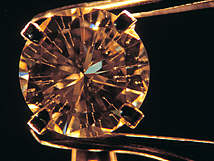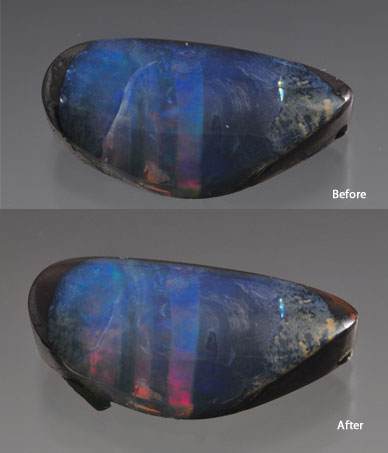Gemstone Treatments
Gemstone treatments can enhance a stone’s beauty. But can you detect them and how do you disclose them? Learn about the most common techniques.
Sealing Cracks in Gemstones
An old lapidary taught me an excellent trick for sealing cracks in gemstones. Some gems are inherently unstable. If a...
Read More
Pearl Treatments Explained
Since the beginning of time, man has sought to improve upon nature. Pearls are no exception. The majority of today's...
Read More
Gemstone Coloration and Dyeing – Introduction
The prime requisite for coloration of gemstone is that it be porous . That is to say there must be...
Read More
Gemstone Care Tips
Many gemstone owners enjoy wearing their treasures. Few things can ruin that enjoyment faster than the discovery of damage such...
Read More
Beryllium-Diffused Blue Sapphire
Beryllium diffusion typically brightens the color of ruby or sapphire, making a stone more yellow, orange, or red, depending on...
Read More
Gemstone Fluorescence
Fluorescence is the emission of visible light from a substance under the stimulation of radiation of a shorter wavelength. It...
Read More
Colored Stone Light Source
Can the colored stone industry choose a standard light source from the multitude on the market?
Read More
Enhancing the Stone – An Update on Diamond Treatment
A summary of the most common treatment techniques used on diamonds, how they are identified by trained gemologists, and what...
Read More
Gemstone Coloration and Dyeing – Pinks and Reds
There are only a few inorganic processes, in my experience at least, that will impart pinks or reds to gemstone....
Read More
Detecting Golden Pearl Color Enhancement
When the first warnings about color enhancement of golden South Sea pearls came out five years ago, fear struck the...
Read More
Chemically Induced Inclusions – Dendrites Moss Plume
Dendrites, moss, plume and similar inclusions have added interest
and value to gemstone for about as long as man has...
Read More
Gemstone Coloration and Dyeing – Table of Contents
This book is the culmination of some twenty-five years of personally supported research on the use of inorganic chemicals to...
Read More
Gemstone Chemical Coloration Techniques
The most important detail in the preparation of gemstone for chemical coloration is that it be clean. Oil and grease,...
Read More
The Treatment of Gemstones
The treatment and enhancement of gemstones has existed for centuries. Some enhancements improve on nature slightly, are undetectable, and they...
Read More
Handling Colored Stones at the Bench Part 2
I’m hoping this series of articles will save some of you time, money, and embarrassment by discussing some of the...
Read More
Gem Creation and Enhancement
Historically gem possession has been reserved for wealthy, royalty, or high religious leaders. It has always been human nature to...
Read More
Gemstone Coloration and Dyeing – The Blacks
There are only two ways that I know of to induce black into gemstone. One of these involves carbon while...
Read More
Gemstone Coloration and Dyeing – Cobalt Series
The use of cobalt compounds to impart blue hues to glass, glazes and enamels has been known for centuries. "Cobalt...
Read More
Gemstone Coloration and Dyeing – Copper Series
Various and attractive shades of blue can be induced in gemstone by the use of copper compounds. This is perfectly...
Read More
Handling Colored Stones at the Bench Part 4
I'm hoping this series of articles will save some of you time, money, and embarrassment by discussing some of the...
Read More
Fracture Healing / Filling of Möng Hsu ruby
Foreign affairs - A well-known European dealer sells a 2.5-carat Möng Hsu ruby to a major jeweler in Europe. This...
Read More
Chemically Induced Inclusions – Copper Inclusions
Since the discovery that the principle of electrochemical displacement of metals can be used effectively and easily to induce inclusions...
Read More
Gemstone Coloration and Dyeing – Iron Process
There are several reactions well known to chemists, involving iron compounds and prussiate compounds (ferrocyanides and ferricyanides) that yield characteristic...
Read More
Gemstone Coloration and Dyeing – The Greens
It seems that everyone likes the greens in chemically colored gemstone. Probably this is because greens are almost universally pleasing...
Read More
Handling Colored Stones at the Bench Part 1
Ever since childhood, I’ve been fascinated by rocks and gems. I started cutting cabs more than 40 years ago, and...
Read More
Gemstone Coloration and Dyeing – Browns and Yellows
At first consideration, it might seem poor organization to include browns and yellows in the same chapter. However, I do...
Read More
Lead Glass-Filled Rubies
GIA recently released a video that provides an overview of lead glass-filled rubies and explains why it has begun to...
Read More
Chemically Induced Inclusions – Tin Inclusions
Tin inclusions can be induced in agate and other gemstone varieties in much the same way as with copper. Just...
Read More
GemBits – Gemstone Enhancements
Which is the best to buy: natural, enhanced, imitation, artificial or synthetic gems? The answer depends on how you plan...
Read More
The All-In-One Jewelry Making Solution At Your Fingertips
When you join the Ganoksin community, you get the tools you need to take your work to the next level.
Trusted Jewelry Making Information & Techniques
Sign up to receive the latest articles, techniques, and inspirations with our free newsletter.




